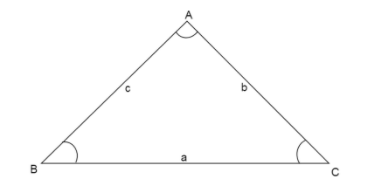Question
Question: In a triangle, the lengths of two larger sides are \[10\] and \[9\] respectively. If the angles are ...
In a triangle, the lengths of two larger sides are 10 and 9 respectively. If the angles are in A.P, the length of the third side can be? (Multiple correct choices)
A. 5−6
B. 33
C. 5
D. 5+6
Solution
We first take the angles in general form of an AP and then use the property that the sum of three angles of a triangle is supplementary to find one angle. Then we apply the law of cosine on that angle and solve for the value of the third side.
- If one side of a triangle is longer than the other side of the triangle then the angle opposite to the longer side will be larger than the angle opposite to the shorter side.
Formula used:
- An arithmetic progression (A.P) is a sequence of numbers which always have the same difference between them. In an A.P with the first term a and common difference d, we can write the nth term using the formula an=a+(n−1)d, where an is the nth term of A.P.
- Law of cosines states that if we are given lengths of two sides of a triangle and the angle between them, then we can find the length of the third side using the formula cos(A)=2bcb2+c2−a2 where the △ABC has sides AB=c,BC=a,CA=b opposite to angles ∠C,∠A,∠B respectively.

Complete step-by-step answer:
Since we are given the lengths of two sides of a triangle in which one is larger than the other, we draw a triangle showing the sides of the triangle. Let the triangle be △ABC.

Here in △ABC, the longest side is AB=10, then the shorter side is BC=9 and the shortest side is AC. Let us assume the length of side AC=x
We know the angles of △ABC are in A.P , therefore, they can be written in the form of an A.P where a−d is the first term, then using the formula for the second and the third term we calculate
So, the angles in A.P are a−d,a,a+d. From the figure ∠B=a−d,∠A=a,∠C=a+d
Now, since a+d is the largest angle, therefore it must be opposite to the longest side.
So, ∠C is opposite to AB=10
Second largest angle a will be opposite to the second longest side.
So, ∠A is opposite to BC=9
Then the smallest angle a−d will be opposite to the shortest side.
So, ∠B is opposite to AC=x.
Now since we know the sum of all three angles of a triangle is equal to 180∘.
In △ABC,
⇒∠A+∠B+∠C=180∘
Substituting the values of ∠B=a−d,∠A=a,∠C=a+d, we get
Dividing both sides of the equation by 3
33a=3180∘ a=60∘Therefore, ∠A=60∘.
Now using this angle measure and the sides between which this angle lies, we can apply the law of cosines to find the third side.
We know according to law of cosines, cos(A)=2bcb2+c2−a2 where the △ABC has sides AB=c,BC=a,AC=b opposite to angles ∠C,∠A,∠B respectively. Here on comparing the sides and the angles we see that
∠A=60∘ and c=10,a=9,b=x.
Substituting the values in the formula we get
⇒cos(60∘)=2×x×10x2+102−92
Since we know the value of cos(60∘)=21, therefore the equation becomes
⇒21=20xx2+100−81
Cross multiplying the denominators of sides to the numerator of opposite sides,
⇒20x=(x2+19)×2
Dividing both sides of the equation by two
Shifting all the values to one side to make a quadratic equation
⇒x2−10x+19=0
On comparing with general quadratic equation ax2+bx+c=0,a=1,b=−10,c=19
To find roots of the quadratic equation we use the formula x=2a−b±b2−4ac
Substituting the values in the formula we get
Breaking the value inside the square root as 24=4×6 and using the property mn=m×n
⇒x=210±4×6 ⇒x=210±4×6Now we know 4=±2
⇒x=210±26
Taking 2 common from the values in the numerator and cancelling it by the same value in the denominator.
So, there are two values of the third side 5+6,5−6
So, the correct answer is “Option A” and “Option D” .
Note: Students are likely to get confused while applying the law of cosines formula and write sides length in wrong manner in the numerator. Keep in mind the angle which lies between two sides is taken cosine of, and on RHS of the equation, numerator has sum of squares of two sides between which the angle lies and subtract square of side opposite to the angle and the denominator has twice the product of lines in between which the angle lies.
